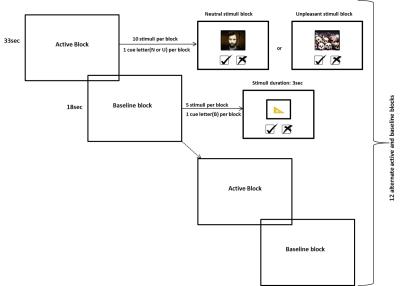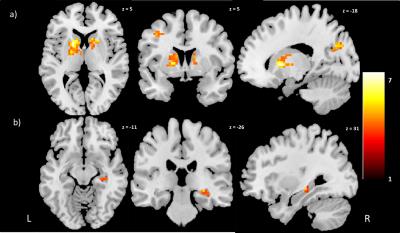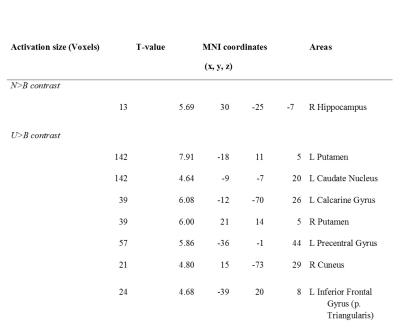5318
The Gut-Brain-Axis: from gut feelings to gut memory1Institute of Psychology, University of Graz, Graz, Austria, 2BioTechMed, Graz, Austria, 3Institute of Chemical Engineering, Graz University of Technology, Graz, Austria, 4Institute of Medical Engineering, Graz University of Technology, Graz, Austria, 5Institute of Experimental and Clinical Pharmacology, Medical University of Graz, Graz, Austria
Synopsis
The present study investigated the effect of probiotic administration on emotional memory in healthy volunteers using fMRI. The preliminary results showed that probiotic intake for 4-5 weeks improved the response accuracy significantly and this was accompanied by a decrease in the neural activity in the brain areas associated with emotions and memory formations. This decrease was more prominent for unpleasant stimuli as compared to neutral stimuli. Considering the scarce literature on gut microbiota and brain interactions in humans, our findings might provide a gateway for further understanding of mechanisms of gut-brain interactions and their effect on emotions and memory.
Introduction
Emerging neurological research has revealed the importance of gut microbiota to the function of the central nervous system (CNS). Bidirectional communication between the brain and the gut has long been recognized in various animal studies1. These studies have shown that experimental manipulations of the enteric microbiome can modify the host’s neural function. However, in contrast to the strong preclinical evidence linking alterations in emotional behavior to prolonged probiotic intake, there is only suggestive evidence that a similar relationship might exist in humans2,3,4 .To date, there is only one neuroimaging study5, that has demonstrated such modulation of neural functions in humans using an emotional attentional fMRI task. This study showed that a four week intake of probiotics by healthy women affected the activity of brain regions that control central processing of emotions and sensation. Considering memory and emotions are inseparable, we hypothesized that the reactivity to an emotional memory task and underlying brain circuits in humans could also be influenced by gut to brain signaling. Additionally, we expected that the probiotic intake can improve emotional memory in healthy subjects.Material and Methods
The study used a double blind, randomized, pre- and post-intervention (4-5 weeks) assessment design. A total of 45 participants (mean age (years) = 26.24, SD = 4.76; 22 male, 23 female) were recruited for the study and were divided into three groups: one intervention group, PRP (which took probiotics, n=15), and two control groups, PLP (which took placebo, n=15) and NI (with no intervention, n=15). The study was approved by the local ethics committee and all participants gave written informed consent. The probiotic formulation (Ecologic®825, Winclove Probiotics, The Netherlands, on the market as OmniBiotic® Stress Repair, Institut Allergosan, Austria) was composed of different strains of Lactobacillus and Bifidobacterium bacterium, whereas the placebo was composed of only maize starch and maltodextrins. The scanning measurements were carried out using 3T whole body MR system (Magnetom Skyra, Germany) with a 32 channel receive-only head coil. EPI sequence (field of view = 256 mm, TE = 27 ms, TR = 3s, flip angle = 90°, slice thickness = 4 mm, voxel size = 4×4×4 mm3) was used to acquire the fMRI data. T1-weighted 3D gradient echo (MPRAGE) sequence (No. of slices = 192, field of view = 224 mm, TE = 1.89 ms, TR = 1.68s, flip angle = 90°, slice thickness = 0.88 mm, voxel size = 0.9×0.9×0.9 mm3) was also acquired coplanar with the EPI scan. The participants were shown neutral and unpleasant pictures contrasted with baseline (geometric) pictures in the first scanning session. In the second scanning session (after one hour), they performed a recognition task (Fig.1). SPM12 was used for data processing. One sample t-test, paired t-test and one-way ANOVA were performed for within and between group analyses. The statistical result of each method was corrected for multiple comparisons using AlphaSim implementation in the REST toolkit. The behavioral statistical analysis was performed using SPSS software.Results and Discussion
Behavioral results indicated that after 4-5 weeks of intervention, the PRP group showed improved response accuracy for unpleasant stimuli (F=4.2; p=0.02) as compared to the PLP and NI groups. The fMRI data revealed that after 4 weeks of intervention, the PRP group showed a decrease in neural activity in the neutral stimuli>baseline stimuli (N>B) and unpleasant stimuli>baseline stimuli (U>B) contrast. The control groups showed no change. Additionally, the decrease of neural activity in the PRP group was more prominent in the U>B contrast as compared to the N>B contrast (Fig.2.(a, b), Table 1). The areas showing decreased activations in the PRP group have been shown to be involved in memory and emotional processes6. Hippocampus and amygdala are part of the limbic system which is primarily associated with emotion and memory formation and these regions send direct projections to caudate nucleus, frontal gyrus and putamen, and together they influence the memory and learning processes in humans. As unpleasant stimuli elicit more intense emotions than neutral stimuli, the observed decrease in neural activity associated with the U>B contrast of the emotional recognition task points to an impact of probiotics on emotional memory in healthy subjects.Conclusion
The present study is suggestive of an influence of probiotic intake on brain regions associated with memory of unpleasant emotions which leave a pronounced impact on our thoughts. Considering the scarcity of studies on the effect of probiotics on mood and well-being in humans, our findings might provide a gateway for further understanding of mechanisms of gut-brain interactions and their effect on emotions and memory.Acknowledgements
We thank the individuals who served as research participants; Allergosan and Winclove for their support for the study product; and Katharina Gruber for participant recruitment and assistance in behavioral data analysis.References
1. Foster JA, McVey Neufeld KA. Gut-brain axis: how the microbiome influences anxiety and depression. Trends Neurosci. 2013; 36(5), 305–312.
2. Benton D, Williams C, Brown A. Impact of consuming a milk drink containing a probiotic on mood and cognition. Eur J Clin Nutr. 2007; 61(3), 355–361.
3. Messaoudi M, Violle N, Bisson JF, Desor D, Javelot H, Rougeot C. Beneficial psychological effects of a probiotic formulation (Lactobacillus helveticus R0052 and Bifidobacterium longum R0175) in healthy human volunteers. Gut Microbes, 2011; 2(4), 256–261.
4. Steenbergen L, Sellaro R, van Hemert S, Bosch JA, Colzato LS .A randomized controlled trial to test the effect of multispecies probiotics on cognitive reactivity to sad mood. Brain Behav Immun. 2015; 48:258-264.
5. Tillisch K, Labus J, Kilpatrick L, Jiang Z, Stains J, Ebrat B et al. Consumption of fermented milk product with probiotic modulates brain activity. Gastroenterology, 2013; 144(7), 1394–1401.
6. McGaugh JL. The amygdala modulates the consolidation of memories of emotionally arousing experiences. Annu Rev Neurosci, 2004; 27: 1–28.
Figures


